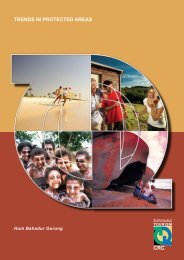icolls - Sustainable Tourism CRC
icolls - Sustainable Tourism CRC
icolls - Sustainable Tourism CRC
You also want an ePaper? Increase the reach of your titles
YUMPU automatically turns print PDFs into web optimized ePapers that Google loves.
ECOLOGY, THREATS AND MANAGEMENT OPTIONS FOR SMALL ESTUARIES AND ICOLLS<br />
Table 10: Dietary categories in the stomach contents of S. ciliata and M. cephalus in Belongil and Tallows<br />
Creeks<br />
Species Sillago ciliata Mugil cephalus<br />
ICOLL Belongil Creek Tallows Creek Belongil Creek Tallows Creek<br />
Number n=27 n=2 n=10 n=13<br />
Taxa %F %N %V %F %N %V %F %N %V %F %N %V<br />
Crustacea - - - 50.0 8.2 7.5 - - - 7.7 98.1 4.6<br />
Decapoda - - - 50.0 0.6 5 - - - - - -<br />
Isopoda - - - - - - - - - - - -<br />
Amphipoda - - - 50 7.6 2.5 - - - 7.7 98.1 4.6<br />
Polychaeta 100.0 41.7 84.3 100.0 2.5 55.0 - - - - - -<br />
Mollusca 44.4 59.7 13.5 50.0 5.0 10.0 - - - - - -<br />
Bivalvia 44.4 59.7 13.5 50.0 5.0 10.0 - - - - - -<br />
Gastropoda - - - - - - - - - - - -<br />
Teleosts - - - - - - - - - - - -<br />
FW Inverts * - - - 100.0 8.4 7.5 - - - 7.7 1.8 0.4<br />
Sediment - - - - - - 50.0 *** 45.0 - - -<br />
Algae 3.7 *** 1.8 - - - 40.0 *** 40.0 92.3 *** 57.3<br />
Plant Material - - - 50.0 *** 2.5 - - - 30.7 *** 2.3<br />
Other 3.7 *** 0.4 50.0 *** 17.5 20.0 *** 15.0 61.5 *** 35.4<br />
%F = Frequency of occurrence, %N = percentage contribution by number, %V = volume of the dietary categories in the stomach contents; *<br />
FW Inverts were collapsed into one category due to the occurrence of specific taxa (Chironomids – S. ciliata, Coleopterans – A. australis and<br />
Hemipterans – M. cephalus); *** indiscrete dietary items inappropriate for numerical classification.<br />
The diet of P. fuscus from Tallows Creek was consistently less diverse than those of the other three teleosts<br />
(Table 9 and 10). Guts from P. fuscus were comprised predominately of decapods of the genus Metapenaeus<br />
(62.5%V), and unidentifiable teleosts (31.67%V) (Table 9 and 10). In Belongil Creek, individuals with gut<br />
contents had only fed on teleosts (Table 9 and 10). Interestingly the diet of P. fuscus generally consisted of a<br />
single large prey item swallowed whole (G. Russell, personal observation).<br />
Reconstructing the diets of M. cephalus individuals is notoriously difficult given their benthic feeding habits<br />
and their tendency to consume large quantities of unidentifiable material. In this study, all individuals had<br />
relatively full stomachs (Table 8). Large quantities of sediment, algae and unidentifiable particulate matter made<br />
up the bulk of diets, except for one large individual collected from Tallows Creek which had consumed<br />
crustaceans and aquatic insects (Table 9 and 10). For that individual, about 10% of the stomach volume was<br />
taken up by these aquatic macroinvertebrates.<br />
Polychaete worms were by far the most commonly consumed prey item in the diet of S. ciliata, as<br />
emphasised by the fact that they were present in all guts (with contents) across both ICOLLs (Table 8).<br />
Volumetrically, polychaetes contributed 84.26% and 55% of the diets of S. ciliata in Belongil and Tallows<br />
Creeks respectively (Table 8). Bivalve molluscs were the second most important item by volume in each location<br />
and were the dominant item ingested by number at Belongil Creek (59.72%). Crustaceans, namely decapods and<br />
amphipods, occurred in 50% of the individuals from Tallows Creek, but none were recorded from the guts of any<br />
of the 27 individuals analysed from Belongil Creek.<br />
Stable isotope analyses<br />
Given the appreciable number of individuals collected with no gut contents (Table 8), there were many more<br />
individuals whose diets were assessed using stable isotope data relative to gut contents data. For example, while<br />
only 27 S. ciliata individuals had prey items in their guts, 36 individuals were available for stable isotope<br />
analyses. This is because stable isotope analyses of diets tend to be based on muscle tissue isotope signatures and<br />
does not therefore rely on the presence of prey items in individual guts.<br />
In many instances, small catch sizes in one or both ICOLLs prohibited comparisons of gut contents and<br />
stable isotope analyses. For example, A. australis and S. ciliata catches in Tallows Creek were extremely low<br />
(relative to Belongil Creek) so comparisons of the two methods were only possible for the Belongil Creek<br />
individuals. Similarly, there were too few individuals (with and without gut contents) to facilitate comparisons<br />
between gut contents and stable isotope dietary reconstructions for P. fuscus (Table 8).<br />
41











